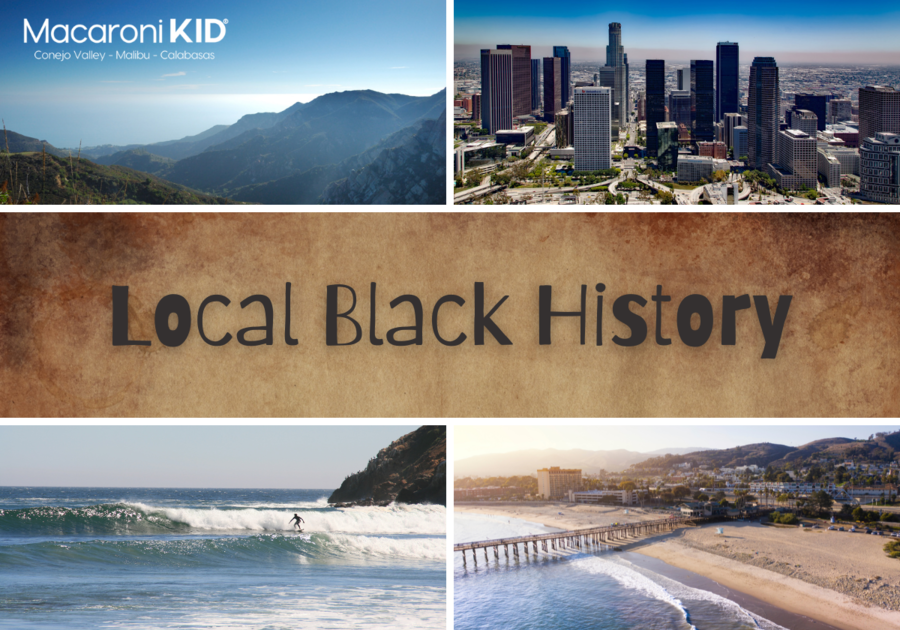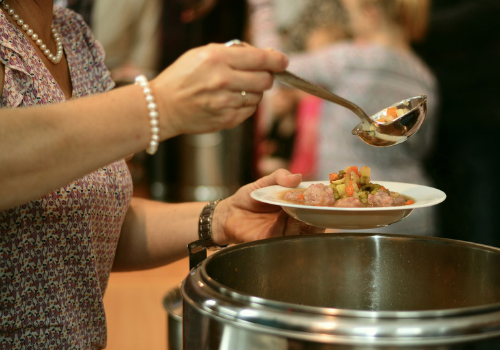Black History is not exclusive to "other" parts of our great nation, there were so many people and places that made their mark and influenced our country's history right here in California and our local communities in and around Los Angeles and Ventura County. Did you know the name "California" came from a 16th century Spanish novel with a dark skinned warrior queen named Calafia from the Island of California?
We all know the "big" names and places, but let's take the time to also learn about some of the lesser known California, Los Angeles and Ventura County local historical people and places with our families. Although many notable people and places are centered in or near northern California and Los Angeles, we did have our own locals who made history right here in Agoura Hills, Malibu and nearby in Ventura. Much of what I discovered was new to me and might be to you too. This story begins before the United States was officially a country, way back when California was a Spanish colony then later a territory of Mexico.
February is Black History month, but there is no reason we shouldn't be learning about, honoring and celebrating the people and the places who helped change our nation, our state and our local communities - all year long.
Are you looking for fun things to do with your family? Why not have fun and learn at the same time by visiting some of these local historical places, parks and museums next time you are looking to head out for a day of adventure with your family in or near Conejo Valley, Los Angeles and Ventura County!
Early California History
Afro-Latinos from Mexico
Among the earliest non-indigenous people to arrive in California were hundreds of people descendant from African slaves who were originally taken to Mexico during the fifteenth and sixteenth centuries. Spanish Captain, Juan Bautista de Anza led an expedition in 1774 to opened up a new supply route from northern Sonora to California. With the establishment of this overland route, many Afro-Latinos migrated to California from Mexico, making up about 20 percent of the area's population by 1790.
Unlike the rest of America, California was a place where Afro-Latino, Mestizo, European, and Indigenous people lived side by side, frequently intermarrying. For the most part, early California provided Afro-Latinos with opportunities they wouldn't have had in Mexico either, where rights and privileges were reserved for Spaniards of “pure blood.” Although European-born Spaniards controlled most of California society, Afro-Latinos and Mestizos did manage to gain some political and economic influence during the Spanish and Mexican periods of California's early days. These early settlers changed the landscape when they established towns and settled ranches across the state, most notable in; Los Angeles, San Diego, Monterey, and San Jose. Some acquiring properties and wealth along the way, as well as serving in high-ranking positions in both the military and the government. By contrast, most Black people in the United States in the eighteenth and early nineteenth centuries were enslaved - even "free" African-Americans enjoyed few, if any, legal rights in the U.S.
Mid 1800s
In early 1848 gold was discovered in northern California, as news of the discovery quickly spread it brought an influx of people migrating from all over, including both free and enslaved Black people from across the U.S. Not long after California was taken over by the U.S, and unfortunately for the Afro-Latino and Mexican people who lived here, dramatic changes occurred, not all for the better. Even though slavery was not legal in California some with legal authority chose to enforce the U.S. Fugitive Slave Act of 1850, then in 1852, California legislators passed a fugitive slave law, both resulting in the deportation of some African-American migrants out of state and back into slavery with their owners. Although California was a "free state" in 1850 when it joined the Union there was a move by many to secede the lower part of the state and join the Colorado Territory which would have allowed slavery. The succession was supported by over 75 percent of the voters and signed off by the governor, but it still required the approval of the U.S. Congress, since the Civil War broke out shortly after the vote, succession never happened leaving it as a long forgotten footnote in our history.
The first census of California in 1850 counted 962 Black people in the state, increasing to 4,086 by 1860, and by 1910 the state's Black population was up to 22,000. The African-American population surged again during and after World War II as even more Black people came to the state and settled here seeking opportunities and an escape from segregation in the rest of the U.S.
The Great Migration: 1910-1970
One of the largest movements of people in the U.S. during the 20th century was known as "The Great Migration," a time when many Black people in U.S. made the move from more rural areas in the South to larger cities all over the U.S. - mostly in the North and West. The migration had two phases; the first from 1910-1940 to mostly northern states, but the second from 1940-1970 brought a surge to California.
West-Coast Hip Hop Music
California has long been the birthplace for many trends including art, music, style and culture. One influential contribution came from the African-American music scene known as West-Coast Hip Hop. While Rap and Hip Hop originated on the East Coast, California added it's own spin after emerging from the many house parties featuring DJs and dancing in mostly Southern California during the 70s and 80s giving rise to "West-Coast Hip Hip."
- The Westside Dance Movement That Laid the Foundation for West Coast Hip-Hop
- Uncle Jamm's Army
- Documentary: Set in the West: A History of L.A. Hip Hop
- 51 Best West Coast Rappers Of All Time
Landmark Legal Cases in California:
Here are just a few of the early landmark civil rights cases in California and Los Angeles, several of which created precedent leading the way to successful wins for national civil rights cases.
- Mason v. Smith 1856: Bridget "Biddy" Mason along with her extended family of thirteen in all were granted their freedom from slaveholder Robert Smith when their case was brought before Judge Benjamin Hayes in Los Angeles - becoming the most significant slave case in Southern California.
- C.A. Stovall v. Archy 1858: A slave named Archy Lee was brought to California from Missouri by his owner Charles Stovall. Later when Stovall planned to return with Archy back to Missouri, he took his case to court - he lost. He later won his freedom in 1858 when his case went before the California Supreme Court.
- Wysinger v. Crookshank 1890: Brought before the Supreme Court of California, it abolished school segregation of African-Americans in the state of California and set legal precedent for the U.S. Supreme Court case "Brown vs. Board of Education" enabling school integration nationwide.
- Fairchild v. Raines 1944: A Black family who moved into a race restricted neighborhood in Pasadena, CA was sued by their White neighbors to have them removed with claims they were hurting the neighborhood. They initially lost the case, but appealed to the California Supreme court where the case was dismissed.
- The "Sugar Hill" case 1945: Famed Oscar winning actress Hattie McDaniels and several of her prominent Black neighbors were sued by some of their White neighbors wanting to have them evicted from their homes in the West Adams Heights neighborhood based on an old race restriction covenant. Judge Thurmond Clarke, Los Angeles Superior Court ruled restrictive covenants violate the California Constitution and the 14th Amendment. This precedent setting case was a major victory for the civil rights movement nationwide.
Explore more of California's Black History:
- Afro-Latino Presence in Early California
- Discovering Early California Afro-Latino Presence
- Afro-Latinidad on the Anza Trail
- Cajon Pass brought first black pioneers to San Bernardino Valley
- The Black 49ers
- Key Points in Black History and the Gold Rush
- The Negro trail blazers of California, published 1919 by Beasley, Delilah L.; a compilation of records from the California archives in the Bancroft Library at the University of California, in Berkeley; from the diaries, old papers, and conversations of old pioneers in the State of California
- Historically Black Neighborhoods in Los Angeles County
- Betty Hill’s ‘bath house’ battle: Until 1931, public swimming pools were only open to Black Angelenos one day a week
About Alta California
Alta California refers to “Upper” California in New Spain - Nueva España, roughly encompassing what is currently the states of: California, Nevada, Utah, and Arizona north of the Gila River, along with parts of Colorado, Wyoming, and New Mexico.
- NPS: Early history of the California Coast
- Library of Congress: Spanish California
- Library of Congress: Mexican California
- Kiddle: Alta California facts for kids
- Kiddle: List of governors of California before 1850 facts for kids
Los Angeles County Black History
Pio de Jesus Pico (1801-1894), born on May 5th to José María Pico and María Eustaquia Gutierrez at Mission San Gabriel Arcángel where his father served as corporal of the guard. He was Afro-Mexican, as were many people living in Alta California at the time. His life in what later became California spanned almost the entire 19th century under the flags of Spain, Mexico, and the United States - a century in which he played a major role in shaping, mostly from Los Angeles.
He served as governor of Alta California twice, the second time he was the last one to serve under Mexican rule, serving from 1845-46 just before the U.S. military occupation. When California first joined the U.S. he fled to Mexico, later returning to live and prosper in the State of California where he continued to take an active role in its development. Sadly due to some bad business dealings, his inability to speak or read English and natural disasters such as floods at “El Ranchito” this generous businessman was left in financial ruins. He died penniless at the home of his daughter Joaquina Pico Moreno in 1894.
His former home still stands and you can visit the Pico House - his legacy can be seen in the numerous places named after him, such as Pico Boulevard, Pío Pico State Historical Park, the City of Pico Rivera, and on numerous schools and monuments throughout the Southland.
- The Life and Times of Pío Pico, Last Governor of Mexican California
- Pio Pico was the last governor of Mexican California. He was of African, Indian, and Spanish ancestry
- Whittier Museum: Pio Pico
- San Diego history of Pio de Jesus Pico
Bridget "Biddy" Mason (1818-1891) was born a slave and lived in Georgia, South Carolina and Mississippi. In 1847 the last of her many owners, Robert Marion Smith took her along with his family on a journey out west (her walking all the way behind the wagons), where he helped establish a new Mormon community in what was then Mexico - now Salt Lake City, Utah. Then in 1851 the Smith family took their slaves and headed to settle the Mormon colony of San Bernardino in California despite being warned that slavery was illegal in the state. Along the journey Biddy encountered "free" Blacks who urged her to contest her slave status once she was in the "free-state" and even more so once she arrived. In December 1855 Robert Smith concerned about losing his slaves decided to take them and head to Texas, a slave state. Her new friends found out and alerted the Sheriff who stopped them from leaving. Biddy then petitioned the court on January 19, 1856 for her freedom, the judge ruled in her favor making her a "free" woman.
She settled in Los Angeles with her family where she worked hard, saved her money and purchase land in what's now downtown L.A. Due to her shrewd investments, Mason was the wealthiest African American woman in Los Angeles by the late 1800s. She spoke fluent Spanish and was a well-known figure downtown, and dined on occasion at the home of Pio Pico, a wealthy Los Angeles land owner and former governor. She organized the First A.M.E. Church, now the oldest African-American Church in the city and she used her philanthropy for helping others.
- You can also visit Biddy Mason Memorial Park, in L.A.
- Free Forever: The Contentious Hearing That Made Biddy Mason A Legend
- Charles Owens, son of Robert Owens and married to Ellen Mason, Biddy's daughter
- Robert Curry Owens, grandson of Biddy Mason
- The Biddy Mason Charitable Foundation
Ruth Janetta Temple (1892-1983), recognize as the first Black woman physician in California. Born in Natchez, Mississippi, she came to Los Angeles with her family when she was young. She developed an early interest in pursuing medicine and after an impressive speech in front of local Black leaders where one was so impressed he helped fund her education. She was the first Black woman to graduate from the College of Medical Evangelists, now known as Loma Linda University. She had a passion for and later specialized in obstetrics and gynecology. She left for a time to attend Yale where she graduated with honors earning her masters degree returning afterward back to L.A.
She was an advocate for underserved communities in Los Angeles. Unable to secure funding, she and her husband, real estate developer Otis Banks purchase a five-room bungalow in south-east L.A. then converted it so she could open a community clinic out of their home. The Temple Health Institute was the only clinic in the area and offered free medical services along with health education. Her clinic eventually became a model for others across the country. She was a faculty member at White Memorial Hospital in Los Angeles where she taught white medical students, she overcame many racial prejudices during that time.
She was also director of the Division of Public Health for L.A., she retired in 1962. Her help was instrumental during several local public health crises. She was later honored with the renaming of the East Los Angeles Health Center to the Dr. Ruth Temple Health Center in 1983, she passed away a year later at the age of 91.
- Dr. Ruth Janetta Temple a Los Angeles Public Health Icon
- Encyclopedia of Seventh Day Adventist: Temple, Ruth Janetta
- Black Past: Ruth Janetta Temple
John Ballard (1850-1905), a former slave arrived in Los Angeles from Kentucky, and became the first Black homesteader in the Santa Monica Mountains in what's now Agoura Hills. Years later his daughter Alice, also became a homesteader on the adjacent land expanding the family property. The local mountain where this family lived for many years was referred to by a not so nice name, it even appeared on some early maps of the area. Not so long ago this wrong was turned right and the Mountain has been renamed Ballard Mountain to honor the family that settled there years ago. John was not the only remarkable Ballard, his descendants are noteworthy in their own rights.
More about the Ballard family:
- Claudius, John's grandson, was a Berkeley-educated doctor who fought during World War I and was awarded the Croix de Guerre by the French for his bravery.
- Both of Claudius’ sons, Albert "Lucky" and Reggie, fought in World War II.
- Reggie was a Tuskegee airman and after the war he helped desegregate the Los Angeles City Fire Department. He and his wife Margaret had six children, many of whom continue to live and serve their communities in the Los Angeles area.
Charlotta Amanda Spears Bass (?-1969), sources vary on whether she was born in 1874 or 1888 and either in South Carolina or Rhode Island, but no matter she began her work in Rhode Island selling ads and subscriptions for local newspapers, then 1906 came to Los Angeles where she started working at "The Eagle," the oldest African-American newspaper on the West Coast. In 1912 after the death of it's founder she took over, renamed it the California Eagle, she became the first Black woman to own and run a newspaper. By the 1930s it was the largest Black newspaper on the West Coast, with a circulation of approximately 60,000. She was also an activist for social justice and use the voice of the paper to help further these causes. In 1951 she sold the paper and moved to New York where she became involved in politics - she was the first Black Woman to be nominated and run for Vice President of the U.S. in 1952, later returning to California where she continued to be active in the movement.
Watch: Charlotta Spears Bass: The First Black Woman VP Nominee
Paul Revere Williams (1894-1980), born and raised in Los Angeles, he was one of the most influential architects in American history. He had to overcome racism, since many of his clients didn't want to sit next to a Black man he learned to draw upside-down so they could see the drawings right side up from across the table.
Martin Luther King Jr.
Although MLK was not from Los Angeles he did spent time here and had an important impact here - his legacy lives on in L.A.
Thomas "Tom" Bradley (1917-1998) was born in Texas and came to Los Angeles with his family during "the great migration" when he was seven years old. Tom grew up in the heart of L.A.'s black community on Central Avenue. He attended UCLA, later leaving to join the LAPD in 1940 where he served for 21 years after rising to the rank of Lieutenant in 1958 while going to law school. He left the LAPD in in 1962 to practice law - this was not an easy time to be an officer as black and white officers would not be allowed to share a patrol car until 1964. He served as controller for the city in 1961 before winning a seat on the L.A. City Council in 1963-1972. He lost his first run for mayor in 1969 to incumbent Sam Yorty setting the stage for the second and successful run.
The grandson of a slave he became the first Black Mayor of Los Angeles, serving five terms from 1973-1993. During his time as mayor he also ran for and won the primary race for Governor of California twice losing both times in 1982 and 1986. He served the city in a period of tremendous growth as well as some great and not so great times in its history. The Watts rebellion in 1965 happened during his term on the L.A. City Council and the Rodney King incident, verdict and uprising (1991-1992) near the end of his mayoral term (possibly why he chose not to run for a sixth term), but one shining highlight was his work in bringing the 1984 Summer Olympics to L.A., a profitable success. He was known to L.A. as the people's mayor, having monthly open house meetings where the community could meet the mayor. He brought diversity to city leadership by opening roles to women, minorities and people with disabilities helping to transform the city like never before. He was also the first African-American mayor elected to a major American city with a mostly white population. After serving the public for five decades he retired in 1993 as his term as mayor of L.A. came to an end.
Learn more about how Tom Bradley changed L.A.
- Watch the documentary - Bridging the Divide: Tom Bradley and the Politics of Race
- Bridging the Divide: Tom Bradley full biography
- Los Angeles' first Black mayor and timeline
- BlackPast: Tom Bradley
- Wikipedia: Tom Bradley
- KCET: Bridging the Divide
Wally Amos
Wallace "Wally" Amos (1936), born in Tallahassee, Florida after serving in the Air Force he moved to New York and worked his way up from mailroom to talent agent at the famed William Morris Agency where he was the first African-American talent agent, signing many major musical acts of the day. After coming to Los Angeles he ended up leaving the agency to start a cookie store in 1975 inspired by his Aunt's chocolate chip cookie recipe. His business had many ups and downs, but one thing is for sure he made his mark in SoCal - he's not just and L.A., but a cookie icon.
- Famous Amos: The Rise and Fall of a Cookie Empire - Wally Amos parlayed his aunt's chocolate chip cookie recipe into a gourmet snack food juggernaut.
Ventura County Black History
According to the 1900 Census there were only 20 Black people listed in all of Ventura County and in 1910 the number increased to 31. Many early African-Americans who lived in Ventura resided in the “Negro Quarter” of Tortilla Flats - a multicultural area. A new wave of African Americans came to Ventura with the jobs created by the Port Hueneme Naval Base in the 1940s, with many also settling nearby in Oxnard.
- Read about Tortilla Flats pg 182 and African-Americans in the county on pg 187 here.
- Preserving the Legacy of Tortilla Flats in Ventura
- MVC Insider EP. 6 (Season 1) — Uncovering Black History
- Museum of Ventura County — Uncovering Black History in Ventura
- Early workers at Olivet Baptist Church, Ventura
- Black Gold Collections: Browse photos of African - Americans on the Central Coast
Cerisa House Wesley's (1898- 1983) birth was the first recorded for an African American child in the city of Ventura. She later left for West Virginia to attend one of the first African American colleges studying to become a nurse. In 1918 there was a worldwide outbreak of influenza spreading fast and infecting about one in four Americans, many died. She returned to Ventura in 1923 as a qualified nurse, but due to the color of her skin she wasn't able to find a job in a hospital. With smaller local flu outbreaks continuing and family and neighbors fearing infection she stepped in helping the poor and dying patients treating them in their homes in Oxnard. In 1974 she was honored by the Ventura County Board of Supervisors for her contributions to the county, including being a founding member of the Olivet Baptist Church, a longtime NAACP member and a volunteer with the County Medical Center auxiliary.
Annie Smith
Annie Smith (1903-1987) born to an early Ventura, African-American family - she was Cerisa Wesley's Aunt, even though she was younger. She helped found the Olivet Baptist Church in Ventura and helped with the Ventura County Fair for over 40 years. .
LeRoy A. Gibson Jr.
LeRoy "Buddy" A. Gibson Jr. another Ventura County local happens to be Cerisa's nephew and his father LeRoy Gibson Sr. was a well known boxer. Over 40 years ago he designed the first Ventura County flag read more here and here.
Read more about LeRoy and his family in his book:
Santa Monica / Malibu Black History
Even though restrictions segregating local beaches the of Southern California ended in 1927, many Black people concerned about discrimination and abuse and chose to go to a Bay Street beach known as the Blackwell for their safety.
Nick Gabaldón, a Santa Monica native of African-American and Mexican heritage, lived from 1927 to 1951. He holds a significant place in history as the first documented Black surfer in mainland U.S. Born and raised in a community where many beaches were unwelcoming to Black individuals, Gabaldon found refuge at a spot known as The Inkwell in Santa Monica.
His love for surfing led him to venture beyond these shores after discovering better waves in Malibu, despite the considerable distance of 12 miles from Santa Monica. Despite the challenges, he paddled out regularly, forming bonds with fellow surfers and earning widespread respect.
Tragically, Gabaldon's life was cut short by a surfing accident, underscoring the risks inherent in his beloved sport. Nevertheless, his story remains a beacon of inspiration, commemorated annually on Nick Gabaldon Day in June for the past decade. Keep an eye out for future events honoring his enduring legacy.
You can learn more about him by watching the documentary 12 Miles North: The Nick Gabaldon Story.
More to explore:
- How Nick Gabaldon Surfed Against Southern California’s Tide of Segregation
- The Legendary Black Surfer Who Challenged Stereotypes
- NICK GABALDÓN - 1927-1951: A Southern California Surfing Pioneer
- Nick Gabaldón: the first documented African American surfer
- The Surf Bus Foundation: Their mission is to empower people to have a healing connection to the sea.
More Notable California African-Americans
Allen Light from the east coast, possibly born in 1805 was a "free" African-American mariner who arrived in Santa Barbara in 1835 when it was part of Alta California under Mexico. He hunted sea otters for their valuable pelts, gained Mexican citizenship in 1839 and guarded the California coastline against American and Native American poachers. He settled in San Diego in the 1840s. There were only eight African Americans or Afro-Latinos (listed as “blacks”) counted in San Diego County on the 1850 census, in Old Town San Diego, African American residents Allen Light and Richard Freeman were property and business owners with prominent standing in the community.
Jack "Jackie" Roosevelt Robinson lived1919-1972, born in Georgia the youngest of five children, his family came to Pasadena in 1920 when he was young. His older brother Mack was also a notable athlete, he was a silver medalist at the 1936 Summer Olympics. After graduating from Pasadena Jr. College Jackie enrolled at UCLA where he became the first athlete at the school to win varsity letters in four sports; baseball, basketball, football and track. He was the first African-American to play Major League Baseball - he played for the Brooklyn Dodgers.
Book: The Hero Two Doors Down by Sharon Robinson, Jackie's daughter
Iris Rideau born in 1937 is the first female African-American winery owner in the United States. In 1997 she established Rideau Vineyard in the Santa Ynez Valley, later selling the vineyard in 2016. That is not even the start of her impressive story. She arrived in Los Angeles with her mother at the age of 12, later dropping out of school, enrolling in night classes and going to work in an office at an insurance agency. Later she founded her own agency and became the first minority / woman owned firm specializing in federally funded programs. She worked closely with Los Angeles Mayor, Tom Bradley to develop the city's first Affirmative Action Program leading to even more accomplishments.
Jerry Lawson
Jerry was an electronic engineer and early pioneer in the video game industry. He was a curious and inventive kid born in Queens, NY whose parents encouraged his love of tinkering and science. His career eventually took him to northern California where he worked in the semiconductor industry. While tinkering at home he built an arcade game and later joined a team at his company where he helped create the first video game cartridge, before that, the game and the console were one. He later left to venture out on his own and founded the first Black owned software company, Video Soft.
- Jerry Lawson Forever Changed the Video Game Industry
- Inventing the Game Cartridge: How Jerry Lawson revolutionized video games
- Vintage Computing & Games Interview: Jerry Lawson, Black Video Game Pioneer
More significant California African-Americans:
- Learn about the first Black firefighter in Los Angeles
- Ralph Bunche: Nobel Peace Prize–winning academic and U.N. diplomat known for his peacekeeping efforts in the Middle East, Africa and the Mediterranean.
- Hattie McDaniel: Much More than Mammy, although not originally from L.A. she left her mark here.
- Lewis G. Green: A Pioneer of the Black Community of Los Angeles, 1850s-1880s
- Black owned Newspaper The Owl, later renamed The California Eagle
- Loren Miller - 1903-1967: Journalist, activist, attorney, judge and Calif. Supreme court judge. Worked on the "Sugar Hill" housing case in L.A., the Shelley v. Kraemer case that struck down racial covenants in America, Brown v Board of Ed. of Topeka, Kansas and helped Japanese Americans with legal battles during WWII.
- Leon H. Washington (1907-1974): Founding publisher of the L.A. based Black owned newspaper, the Sentinel.
- Georgia Ann Hill Robinson: The first black female LAPD officer and possibly the first in the country
- Snapshots from L.A.'s Black History: First black mayor, Fatburger founder and more
- Singer Etta James of L.A.
- Meet L.A.’s Lesser-known iconic Black History trailblazers who shaped our fine city
- Marie Hollis moved to Southern California in 1967 and settled on a one acre lot in Richland Farms
- 10 Influential Black Californians Who Shaped the State
- Olympic gold medalist, Florence "Flojo" Griffith Joyner track star from L.A.
- Compton Cowboys
- L.A. Tennis Stars: Venus and Serena Williams grew up in Compton
- Los Angeles Poets: Amanda Gorman, Wanda Coleman, Morgan Harper Nichols and Shonda Buchanan: Celebrate Black poetry and add these influential figures from California to your reading list
- Frances Albrier: Californian Rights Activist
- Mary Ellen Pleasant was a civil rights activist and entrepreneur who used her fortune to further the abolitionist movement.
- California Firsts in Black History
Local Places to visit and explore Black History:
Learn more about the places that played a significant role in the history of Black people locally in Ventura and Los Angeles Counties. Many of these places you can visit with your kids today.
Parks
Pío Pico State Historic Park - Whittier, CA
- The five acre park encompasses historic gardens and the beautiful restored adobe home of Pío Pico. It is registered as California Historic Landmark NO. 127. A bell marks the original El Camino Real, which passed directly in front of the park during Pío Pico’s time. The park was once part of Pío Pico’s 9,000 acre ranch, Rancho Paso de Bartolo.
Biddy Mason Memorial Park, Los Angeles
Museums
California African American Museum - CAAM | Los Angeles, CA
(213) 744-7432 | located at the corner of Figueroa Street and Exposition Boulevard, just west of the 110 Freeway
Please note: Temporarily closed for repairs - visit website for updates
- Open Tue. - Sat. from 10:00 am - 5:00 pm | Sunday 11:00 am - 5:00 pm | Closed Monday - accept MLK Day
Admission is Free, parking fee is $15-$18 - lot entrance is at 39th and Figueroa Streets.
The African American Firefighter Museum
1401 S. Central Avenue, Los Angeles, CA | (213) 744-1730
- Sunday only: Timed entry, tours start promptly at 1:00 pm, 2:00 pm, and 3:00 pm. Please reserve your ticket and plan to arrive 15 minutes early.
The museum is located at the historic Fire Station #30, which was one of two segregated firehouses in Los Angeles between 1924 and 1955. In 1897 Sam Haskins was the first Black fireman in Los Angeles.
Museum admission is free, but donations are appreciated - open to the public and is strictly volunteer and donation driven. Take a 40 min. guided tour with lots of photo opportunities.
Videos to watch:
- The old Stentorians: Ballard and Anderson: First hand accounts of before and after racial segregation in the Los Angeles City Fire Department.
- AAF Museum historian Brant Burton discuss Museum history and experience of African American firefighters
- Black Women in the Fire Service: Retired LAFD Captain d'Lisa Davies
More museums to explore Black history:
- Hidden History Museum | Mon.-Fri. 11 am - 4 pm | 323-840-3029 | 2131 West Jefferson Blvd, Los Angeles, CA 90018
- Watts Towers Arts Center Campus
- The Museum of African American Art, Los Angeles
- The Ray Charles Memorial Library: a self-guided tour through the life of Ray Charles - by appointment
- Grammy Museum, Downtown L.A.
- Petersen Automotive Museum, Los Angeles, CA
- Battleship Iowa Museum, Los Angeles, CA
- LACMA - L.A. County Museum of Art
- Fowler Museum at UCLA
Historic Black History Locations - In and around L.A.
Historic South Central: Home to L.A.’s Harlem Renaissance
From L.A. in a Minute: Historic South Central is not the “South Central” you see in movies. From the Lincoln Theatre to Central Avenue, the Harlem Renaissance on the West Coast took place in this amazing district. Famous artists and architects and fantastic architecture have laid the foundation of this history.
The history of Allensworth, the first town in California established exclusively by African Americans, founded in 1908 - north of L.A.
More Places to visit:
- Hattie McDaniel Residence, Los Angeles
- The Thrill of Sugar Hill
- Paul Revere Williams House, Los Angeles
- A Brief History of Central Avenue
- Honoring Pioneering Black Architects that Shaped the Built Landscape of Los Angeles
- Jackie and Mack Robinson Memorial, Pasadena, CA: Two groundbreaking brothers from Pasadena
- Jackie Robinson Stadium, Los Angeles
- LAX Theme Building - architect Paul Williams worked on this building
- First African Methodist Episcopal Church, Los Angeles, CA
- Lula Washington Dance Theatre, Los Angeles
- Leimert Plaza Park
- Betsy and Rafer Johnson Track at Drake Stadium, UCLA
Book store
Malik Books - African American Bookstore | Westfield Culver City Mall and Baldwin Hills Crenshaw Mall
Research
Black Resource Center, L.A. County Library - Los Angeles: Research and study social, historical and cultural aspects unique to the African American experience
Stay Tuned - Opening Soon
If you enjoyed this article please share with a friend












